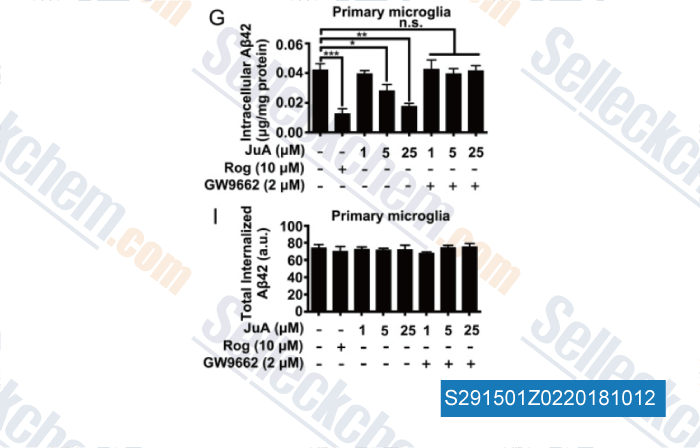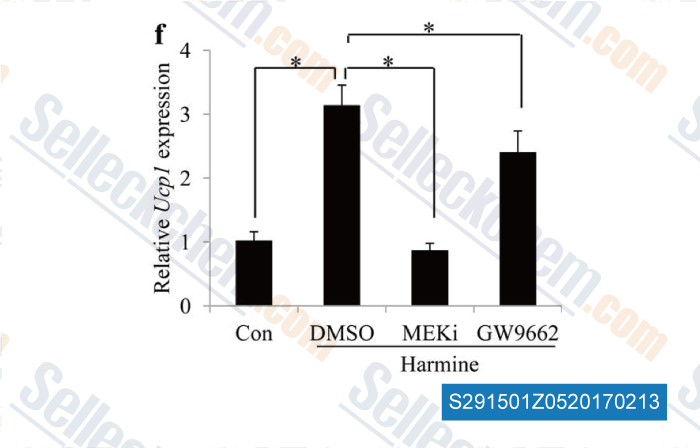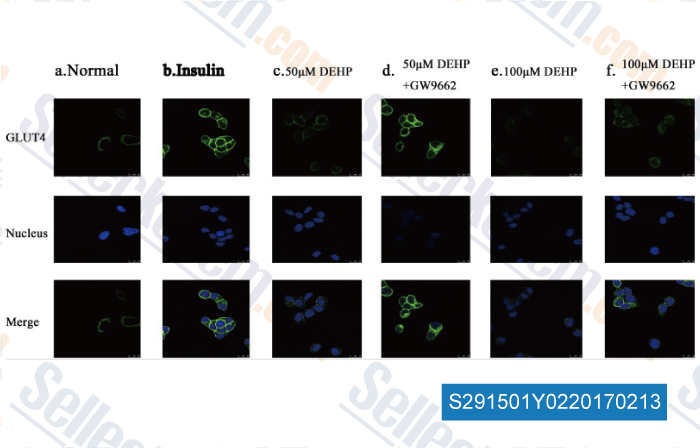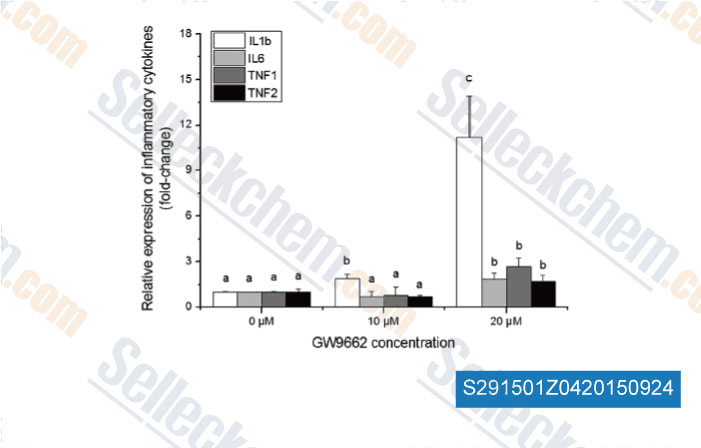|
How to Cite 1. For In-Text Citation (Materials & Methods): 2. For Key Resources Table: |
||
|
Toll Free: (877) 796-6397 -- USA and Canada only -- |
Fax: +1-832-582-8590 Orders: +1-832-582-8158 |
Tech Support: +1-832-582-8158 Ext:3 Please provide your Order Number in the email. We strive to reply to |
Technical Data
| Formula | C13H9ClN2O3 |
||||||||||||||
| Molecular Weight | 276.68 | CAS No. | 22978-25-2 | ||||||||||||
| Solubility (25°C)* | In vitro | DMSO | 55 mg/mL (198.78 mM) | ||||||||||||
| Water | Insoluble | ||||||||||||||
| Ethanol | Insoluble | ||||||||||||||
| In vivo (Add solvents to the product individually and in order) |
|
||||||||||||||
|
* <1 mg/ml means slightly soluble or insoluble. * Please note that Selleck tests the solubility of all compounds in-house, and the actual solubility may differ slightly from published values. This is normal and is due to slight batch-to-batch variations. * Room temperature shipping (Stability testing shows this product can be shipped without any cooling measures.) |
|||||||||||||||
Preparing Stock Solutions
Biological Activity
| Description | GW9662 is a selective PPAR antagonist for PPARγ with IC50 of 3.3 nM in a cell-free assay, with at least 10- to 600-fold functional selectivity in cells with PPARγ versus PPARα and PPARδ. | ||||
|---|---|---|---|---|---|
| Targets |
|
||||
| In vitro | GW9662 binds to Cys(285) on PPARgamma which is conserved among all three PPARs. This compound acts as an antagonist of PPARgamma which is confirmed in an assay of adipocyte differentiation inhibition. [1] It prevents activation of PPARγ and inhibits growth of human mammary tumour cell lines (MCF7, MDA-MB-468, MDA-MB-231) with IC50 of 20 μM-30 μM, suggesting either the existence of PPARγ agonistic properties of this chemical or growth-inhibitory mechanisms independent of PPARγ. Co-treatment with this compound (10 μM) results in statistically lower viable cell numbers after 7 days in MDA-MB-231 cells. [2] PPARγ1 ligands could suppress RANKL-induced osteoclast formation in primary murine myeloid (BMs) and RAW264.7 cells. Importantly, suppression by these ligands is reversed in a concentration-dependent fashion with this chemical (2 μM). It (2 μM) blocks IL-4 suppression of osteoclast formation in BMs. This compound (1 μM) blocks RANKL activation of NF-κB in RAW264.7 cells. [3] GW9662 (10 μM) inhibits hormone- and agonist-induced adipogenesis of primary preadipocytes from patients with thyroid eye disease. [4] |
||||
| In vivo | Pretreatment with LPS (1 mg/kg i.p.) significantly attenuates all markers of renal injury and dysfunction caused by ischemia/reperfusion (I/R) injury in rats. Most notably, this compound (1 mg/kg i.p.) abolishes the protective effects of LPS. [5] |
Protocol (from reference)
| Kinase Assay: |
|
|---|---|
| Cell Assay: |
|
| Animal Study: |
|
References
|
Customer Product Validation

-
Data from [ , , Theranostics, 2018, 8(15):4262-4278 ]

-
Data from [ , , Sci Rep, 2016, 6:36382. ]

-
Data from [ , , Toxicol Appl Pharmacol, 2016, 316:17-26. ]

-
Data from [ , , Fish Shellfish Immunol, 2015, 43(2): 310-24 ]
Selleck's GW9662 Has Been Cited by 82 Publications
| Extracellular Vesicles From Limosilactobacillus johnsonii Enhance Milk Fat Synthesis by Inducing CD36 Dynamic Palmitoylation and Activating PPARγ Signalling [ J Extracell Vesicles, 2025, 14(8):e70143] | PubMed: 40767021 |
| LPS pretreated dental follicle stem cell derived exosomes promote periodontal tissue regeneration via miR-184 and PPARα-Akt-JNK signaling pathway [ Stem Cell Res Ther, 2025, 16(1):347] | PubMed: 40605003 |
| IRF8 aggravates nonalcoholic fatty liver disease via BMAL1/PPARγ axis [ Genes Dis, 2025, 12(3):101333] | PubMed: 40083324 |
| Epigenetic reprogramming via EZH2 inhibition rescues fibroadipose pathogenesis in secondary lymphedema through activating PPARγ signaling [ J Orthop Translat, 2025, 55:309-322] | PubMed: 41079990 |
| Compromised Peroxisome Proliferator-Activated Receptor γ-Mediated Impaired Placental Glucose Transport Via the Phosphatidylinositol 3-Kinase/Protein Kinase B Signaling Pathway Is Associated With Fetal Growth Restriction [ Lab Invest, 2025, 105(4):104103] | PubMed: 39909142 |
| TFPI2 hypermethylation promotes diabetic atherosclerosis progression through the Ap2α/PPARγ axis [ J Mol Cell Cardiol, 2025, 198:45-59] | PubMed: 39631358 |
| Naringin mitigates experimental autoimmune prostatitis by modulating oxidative stress and the NLRP3 inflammasome via the PPAR-γ/NF-κB pathway [ Sci Rep, 2025, 15(1):20843] | PubMed: 40594232 |
| FNDC4 Prevents Aging-Related Cardiac Dysfunction: By Restoring AMPKα/PPARα-Dependent Mitochondrial Function [ JACC Basic Transl Sci, 2025, 10(7):101222] | PubMed: 40464727 |
| FFAR2 expressing myeloid-derived suppressor cells drive cancer immunoevasion [ J Hematol Oncol, 2024, 17(1):9] | PubMed: 38402237 |
| Brain Short-Chain Fatty Acids Induce ACSS2 to Ameliorate Depressive-Like Behavior via PPARγ-TPH2 Axis [ Research (Wash D C), 2024, 7:0400] | PubMed: 38939042 |
RETURN POLICY
Selleck Chemical’s Unconditional Return Policy ensures a smooth online shopping experience for our customers. If you are in any way unsatisfied with your purchase, you may return any item(s) within 7 days of receiving it. In the event of product quality issues, either protocol related or product related problems, you may return any item(s) within 365 days from the original purchase date. Please follow the instructions below when returning products.
SHIPPING AND STORAGE
Selleck products are transported at room temperature. If you receive the product at room temperature, please rest assured, the Selleck Quality Inspection Department has conducted experiments to verify that the normal temperature placement of one month will not affect the biological activity of powder products. After collecting, please store the product according to the requirements described in the datasheet. Most Selleck products are stable under the recommended conditions.
NOT FOR HUMAN, VETERINARY DIAGNOSTIC OR THERAPEUTIC USE.
